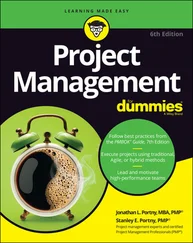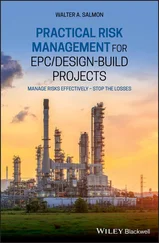Matthew Batchelor - Project Management
Здесь есть возможность читать онлайн «Matthew Batchelor - Project Management» — ознакомительный отрывок электронной книги совершенно бесплатно, а после прочтения отрывка купить полную версию. В некоторых случаях можно слушать аудио, скачать через торрент в формате fb2 и присутствует краткое содержание. Жанр: unrecognised, на английском языке. Описание произведения, (предисловие) а так же отзывы посетителей доступны на портале библиотеки ЛибКат.
- Название:Project Management
- Автор:
- Жанр:
- Год:неизвестен
- ISBN:нет данных
- Рейтинг книги:4 / 5. Голосов: 1
-
Избранное:Добавить в избранное
- Отзывы:
-
Ваша оценка:
- 80
- 1
- 2
- 3
- 4
- 5
Project Management: краткое содержание, описание и аннотация
Предлагаем к чтению аннотацию, описание, краткое содержание или предисловие (зависит от того, что написал сам автор книги «Project Management»). Если вы не нашли необходимую информацию о книге — напишите в комментариях, мы постараемся отыскать её.
Project Management — читать онлайн ознакомительный отрывок
Ниже представлен текст книги, разбитый по страницам. Система сохранения места последней прочитанной страницы, позволяет с удобством читать онлайн бесплатно книгу «Project Management», без необходимости каждый раз заново искать на чём Вы остановились. Поставьте закладку, и сможете в любой момент перейти на страницу, на которой закончили чтение.
Интервал:
Закладка:
1.3 Understand the project life cycle 1.3 Understand the project life cycle All projects have a recognizable ‘life cycle’. There are many different approaches to managing projects, but all agree that projects can be divided into various stages, each requiring a different focus. The most straightforward life cycle approach recognizes four main stages of a project: aspiration, planning, implementation and measurement. You can easily memorize this life cycle because the stages both represent and substitute the words for how A P roject Is M anaged: 1 Aspire This stage focuses on the creation of a shared vision for your project. What are you aiming to achieve and why? How will you recognize and measure success? Whose support will you need to begin the project, and what will convince them to support you? 2 Plan This stage looks in detail at identifying what needs to be done to deliver your project successfully. What are the various tasks that need to be done, and how can they best fit together? Who will you need on your project team? What resources will you need, both financial and physical (equipment, meeting spaces and so on)? What are the main risks to successful delivery, and how can these be avoided (or at least minimized)? Lastly, how will the project be managed, and progress communicated? 3 Implement This stage can be divided into two parts: motivating and monitoring. At the beginning of your project you will need to form and motivate your project team, and agree the project’s aims and working methods. Once your project is underway, your role shifts to monitoring – what progress has been made? What if any changes need to be made to the original plan? Is your project running on time, or has the schedule slipped? Are the costs as expected, or is the project in danger of going over budget? Have any problems been reported and discussed, and any necessary changes to the plan or budget been agreed? 4 Measure Once the project is complete, the final role of the project manager is to determine its success and to communicate the results, so that the lessons learned can be incorporated into other projects. To what extent were the original aims achieved? What went well and what went not so well? What lessons are there for future projects? Adopting a life cycle approach will help you focus on the most important issues at each stage of the project.
1.4 Know your stakeholders
1.5 See your stakeholders’ points of view
1.6 Choose the right approach
1.7 ‘The buck stops here’
Aspire to succeed
2.1 Every masterpiece starts with a sketch
2.2 Get creative!
2.3 SOC it to them!
2.4 Sell the benefits
2.5 Build support
Plan for success
3.1 Define your objectives
3.2 Divide the project into work packages
3.3 First things first (and last things last)
3.4 Build a project timetable
3.5 Add contingency and use it wisely
3.6 Match people to tasks
3.7 Organize and control your project
3.8 Manage risks wisely
3.9 ‘Design in’ quality
Manage your money
4.1 Understand the role of finance
4.2 Estimate project costs
4.3 Choose to insource or outsource
4.4 Choose the right supplier
4.5 Negotiate the right type of contract
4.6 Make a return on your investment
4.7 Freeze the project budget
4.8 Control costs
Lead and inspire your team
5.1 Design in success to your project team
5.2 Understand team dynamics
5.3 Make the most of matrix working
5.4 Tailor your leadership style
5.5 Communication is more than just words
5.6 Learn to manage difficult conversations
5.7 Manage yourself, then the project
Turn your plan into reality
6.1 Plan for change
6.2 Create an open culture
6.3 Get results from team meetings
6.4 Get the data
6.5 Create a balanced project scorecard
6.6 There’s a solution to every problem
6.7 Be lucky!
Maximize project learning
7.1 Know when it’s closing time
7.2 Achieve closure
7.3 Plan to evaluate
7.4 Choose what to measure
7.5 Measure the true return on investment
7.6 Evaluation is a listening exercise
7.7 Never stop learning
Jargon buster
Further Reading
About the Author
Copyright
About the Publisher
Good project management is vital to business success
In today’s highly competitive business world, more and more organizations are moving to a project approach. Whether launching a new, multi-million-dollar product or planning an office move, project management will enable you to deliver high-quality results on time and within budget.
Just as important, it provides a framework for continuous learning and improvement. In my own field of communications, I’ve spent over 20 years as a project manager, delivering projects as diverse as product launches and health conferences. I’ve observed a range of different project management approaches in action, and tried to adopt the best of them to improve the quality of the projects I manage.
Successful project management is about good systems and good leadership, to be sure, but it’s also about exercising good judgement when required. This book will help you develop all three of these skills. It aims to impart what I believe are the 50 most important project management secretsI’ve learnt along the way. These secretsare divided into seven key chapters:
Understand the role of projects.This section introduces you to the world of project management and helps you choose the right approach.
Aspire to succeed.To start your project you need a clear ‘vision’ and the ability to convince people to support your project.
Plan for success.Learn how to use Gantt charts, network diagrams and other essential tools for the project manager.
Manage your money.This section tells you how to build a project budget, manage risks and allocate contingency (extra); it will also help you identify the key areas to focus on to keep costs under control.
Lead and inspire your team.How to recruit, manage and fire up your project team.
Turn your plan into reality.Introduces some of the most common project management software, shows how to monitor progress accurately, and how to diagnose and solve problems.
Maximize project learning.Shows you how to close a project properly and conduct an effective evaluation.
Whether you are an experienced project manager or novice, if you follow these simple rules, you will be more confident in your ability to lead projects succesfully. This book will not only teach you how to act like a project manager but also enable you to think like one!
Understand the role of projects
This chapteraims to give you an understanding of the essential background to project management. It discusses the concept of the project life cycle, introduces the main stakeholders, and describes the role of the project manager. The most popular approaches to managing projects are discussed, along with some of the most popular software tools.
1.1 Projects are not tasks
Before getting started, it’s worth understanding what a ‘project’ actually is. The UK Association of Project Management (APM) defines a project as ‘a unique, transient endeavour undertaken to achieve a desired outcome’. In other words, a project has a defined beginning, middle and end, and a stated purpose.
Managing a project therefore differs from fulfilling a task, programme or professional work role. The following list helps to differentiate a project from other types of work.
Читать дальшеИнтервал:
Закладка:
Похожие книги на «Project Management»
Представляем Вашему вниманию похожие книги на «Project Management» списком для выбора. Мы отобрали схожую по названию и смыслу литературу в надежде предоставить читателям больше вариантов отыскать новые, интересные, ещё непрочитанные произведения.
Обсуждение, отзывы о книге «Project Management» и просто собственные мнения читателей. Оставьте ваши комментарии, напишите, что Вы думаете о произведении, его смысле или главных героях. Укажите что конкретно понравилось, а что нет, и почему Вы так считаете.












